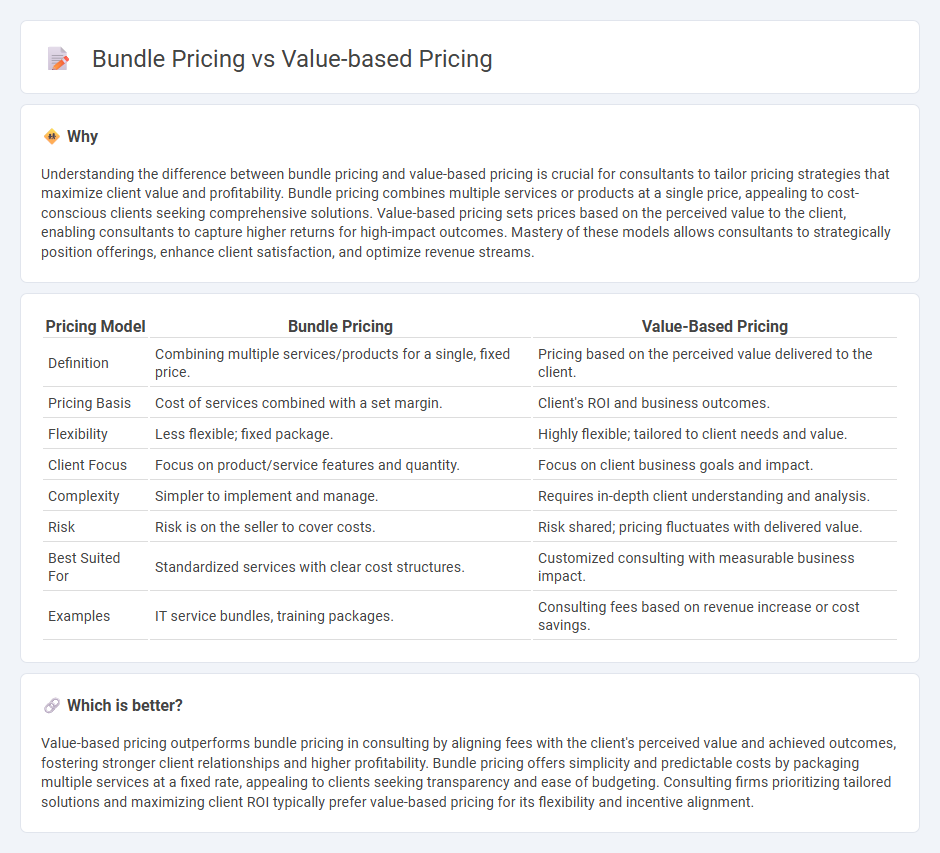
Consulting firms often weigh bundle pricing against value-based pricing to optimize revenue and client satisfaction. Bundle pricing offers fixed packages, simplifying decision-making and encouraging comprehensive service adoption, while value-based pricing aligns costs with the client's perceived benefits, maximizing profitability and customized solutions. Explore the distinctions and strategic applications of these pricing models to enhance your consulting practice.
Why it is important
Understanding the difference between bundle pricing and value-based pricing is crucial for consultants to tailor pricing strategies that maximize client value and profitability. Bundle pricing combines multiple services or products at a single price, appealing to cost-conscious clients seeking comprehensive solutions. Value-based pricing sets prices based on the perceived value to the client, enabling consultants to capture higher returns for high-impact outcomes. Mastery of these models allows consultants to strategically position offerings, enhance client satisfaction, and optimize revenue streams.
Comparison Table
| Pricing Model | Bundle Pricing | Value-Based Pricing |
|---|---|---|
| Definition | Combining multiple services/products for a single, fixed price. | Pricing based on the perceived value delivered to the client. |
| Pricing Basis | Cost of services combined with a set margin. | Client's ROI and business outcomes. |
| Flexibility | Less flexible; fixed package. | Highly flexible; tailored to client needs and value. |
| Client Focus | Focus on product/service features and quantity. | Focus on client business goals and impact. |
| Complexity | Simpler to implement and manage. | Requires in-depth client understanding and analysis. |
| Risk | Risk is on the seller to cover costs. | Risk shared; pricing fluctuates with delivered value. |
| Best Suited For | Standardized services with clear cost structures. | Customized consulting with measurable business impact. |
| Examples | IT service bundles, training packages. | Consulting fees based on revenue increase or cost savings. |
Which is better?
Value-based pricing outperforms bundle pricing in consulting by aligning fees with the client's perceived value and achieved outcomes, fostering stronger client relationships and higher profitability. Bundle pricing offers simplicity and predictable costs by packaging multiple services at a fixed rate, appealing to clients seeking transparency and ease of budgeting. Consulting firms prioritizing tailored solutions and maximizing client ROI typically prefer value-based pricing for its flexibility and incentive alignment.
Connection
Bundle pricing and value-based pricing are connected through their focus on maximizing customer perceived value by offering combined products or services at prices aligned with the overall benefit delivered. Consulting firms use bundle pricing to package multiple solutions while applying value-based pricing to set fees based on the measurable outcomes and client ROI. This strategic combination enhances client satisfaction and drives higher profitability by aligning price with the holistic value provided.
Key Terms
Value Proposition
Value-based pricing centers on setting prices according to the perceived value to the customer, emphasizing benefits and outcomes tailored to individual needs. Bundle pricing combines multiple products or services into one package, offering enhanced perceived value through convenience and savings. Explore more to understand how these strategies impact your value proposition and customer engagement.
Service Customization
Value-based pricing tailors service costs to perceived customer benefits, maximizing revenue by aligning price with individual needs and willingness to pay. Bundle pricing packages multiple services together at a combined rate, promoting convenience and perceived savings while potentially increasing overall consumption. Explore deeper insights into how service customization influences pricing strategies for enhanced customer satisfaction and profitability.
Package Deal
Value-based pricing determines the price of a product or service based on the perceived value to the customer, emphasizing customer willingness to pay rather than cost. Bundle pricing involves offering multiple products or services packaged together at a single price, often lower than the sum of individual prices, to encourage higher sales volume. Explore the strategic advantages and application scenarios of package deal pricing to optimize revenue and customer satisfaction.
Source and External Links
The Value-Based Pricing Guide - NetSuite - Value-based pricing is a strategy where prices are set based on the perceived value to customers, allowing businesses to charge a premium and boost revenues by aligning price with what customers are willing to pay for differentiated offerings.
Value-Based Pricing - Definition, Example, Use - This strategy adjusts prices based on perceived value rather than cost or historical prices, commonly used for prestigious or unique products, and can significantly increase revenue without greatly reducing sales volume.
Value-Based Pricing: A Complete Overview & Guide - Salesforce - Value-based pricing emphasizes the buyer's perceived benefits and outcomes rather than product features, enhancing customer satisfaction, loyalty, differentiation, and stronger customer relationships through deep understanding of customer needs.
 dowidth.com
dowidth.com